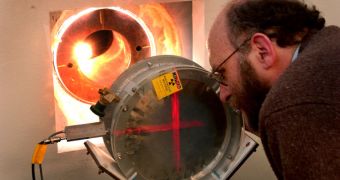Starting in early 2011, repair and upgrade work will begin at the Los Alamos Neutron Science Center (LANSCE), one of the most powerful linear proton accelerators in the United States. Its capability to support experiments and tests will be effectively doubled once work is completed.
The decision to allot the necessary funds was made by the Los Alamos National Security, LLC, the contractor in charge of operating the DOE Los Alamos National Laboratory (LANL), in cooperation with the Los Alamos Site Office, a division of the National Nuclear Security Administration (NNSA).
Over the past ten years, this advanced research facility has been used by the most prominent figures in semiconductor research and industry, in order to simulate for example the effects of cosmic ray-generated neutrons on the electronic devices powering up satellites.
During strong solar storms, massive amounts of charged particles are released from the star's surface, and are then sent hurtling towards Earth. Those that make it here can fry electronics aboard satellites, and set the International Space Station and its crew in jeopardy.
If the storm is strong enough, the charged particles penetrate the planet's magnetosphere and make their way to the surface, where they can fry transformers and destroy power grids.
The linear accelerator at LANSCE was also used to determine how neutrons could affect the electronic chops aboard passenger aircraft, or modern automobiles. These are issues that concern the general public.
An additional use for the facility was in studies aimed at determining the rate at which nuclear weapons age, and the dangers this entails. Such works were essential for informing the United States' national security policies.
“The Los Alamos Neutron Science Center has consistently shown its value to the nation. We are extremely pleased to be able to reinvest in a key LANL facility to ensure continuing scientific excellence and national service,” says Michael Anastasio.
He holds joint appointments, as the director of the LANL, and also as the president of LANS, LLC.
“As integrated circuitry gets smaller and smaller, and operating voltages decrease, the potential for these single-event upsets rises dramatically,” said Steve Wender, referring to interactions between neutrons and electronics.
“Although, the probability that a neutron will disrupt a particular circuit is extremely small – something you might never see during the practical life of the device – the large number of semiconductor devices used in everyday life make the total number of failures significant,” the expert goes on to say.
“At our ICE (Irradiation of Chips and Electronics) House facility, we can simulate hundreds of years of life of a device in a short time, allowing circuit manufacturers to better understand risks of cosmic-ray-generated neutrons and potentially incorporate strategic designs to cope with the risks,” he adds.
“Consequently, ICE House has become an international standard for putting new circuits through their paces,” concludes Wender, who is the leader of the LANSCE neutron and nuclear science group.

 14 DAY TRIAL //
14 DAY TRIAL //